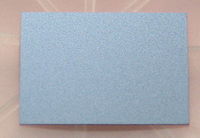
Photo from wikipedia
Abstract The key objective of this work is to comprehensively study the efficiency of doping tellurite glasses with gallium and indium oxides on changes in the optical and gamma-radiation shielding… Click to show full abstract
Abstract The key objective of this work is to comprehensively study the efficiency of doping tellurite glasses with gallium and indium oxides on changes in the optical and gamma-radiation shielding characteristics. The objects under study were 0.5TeO2-(0.5-2x)MoO3-xGa2O3-xIn2O3 glasses with different dopants concentration x, which varied from 0.05 to 0.15 mol. %. Energy-dispersive X-ray spectroscopy (EDS), X-ray diffraction analysis (XRD), and UV–Vis spectroscopy were used as methods of the study. Gamma-radiation shielding characteristics were determined for two types of sources: Co57 (137 keV) and Cs137 (660 keV). Using the methods of EDS, it was found that an increase in the concentration of dopants leads to a partial displacement of oxygen from the glass structure, as well as an increase in density from 3 to 10%. An analysis of the optical properties of the synthesized glasses showed that an increase in the concentration of dopants leads to a change in the transmission, as well as in the band gap energy and optical characteristics. It is also observed that the increase in the concentration of dopants leads to the formation of additional absorption bands. From the evaluations of the shielding characteristics, it can be concluded that the increase in the concentration of dopants makes it possible to reduce the thickness for effective shielding of gamma radiation, and also significantly increases the shielding efficiency.
Journal Title: Optical Materials
Year Published: 2021
Link to full text (if available)
Share on Social Media: Sign Up to like & get
recommendations!